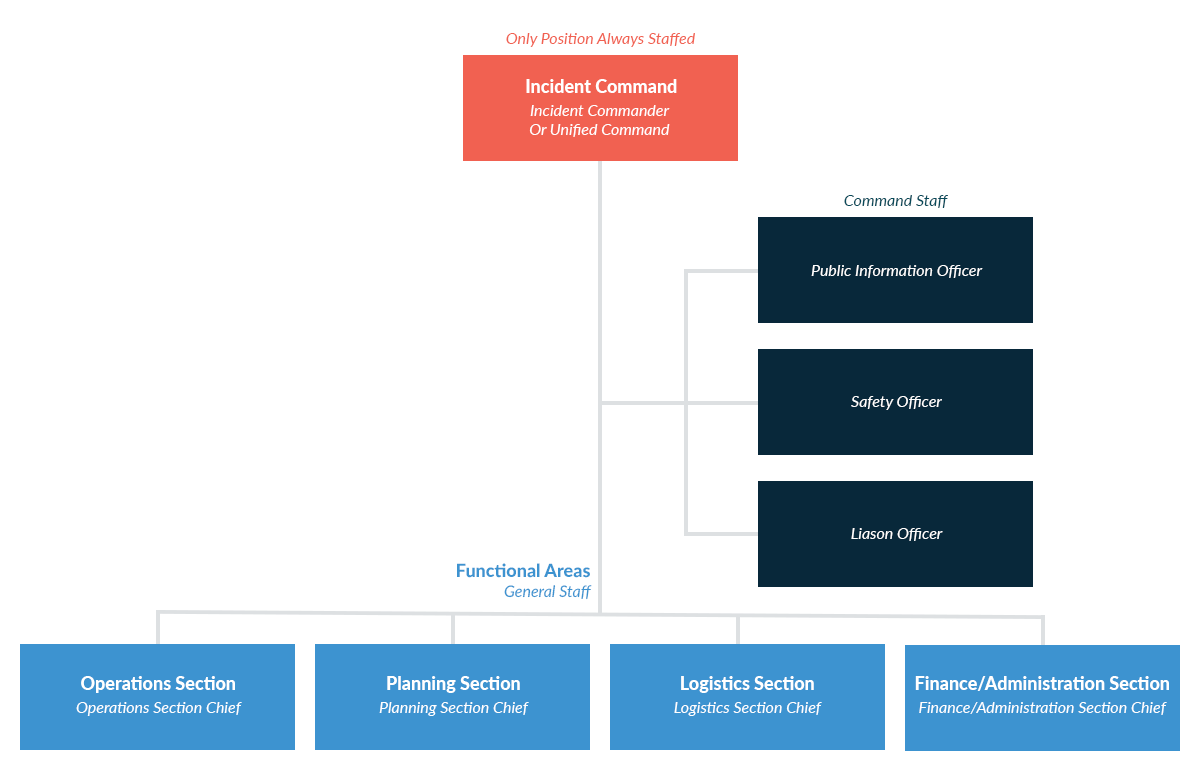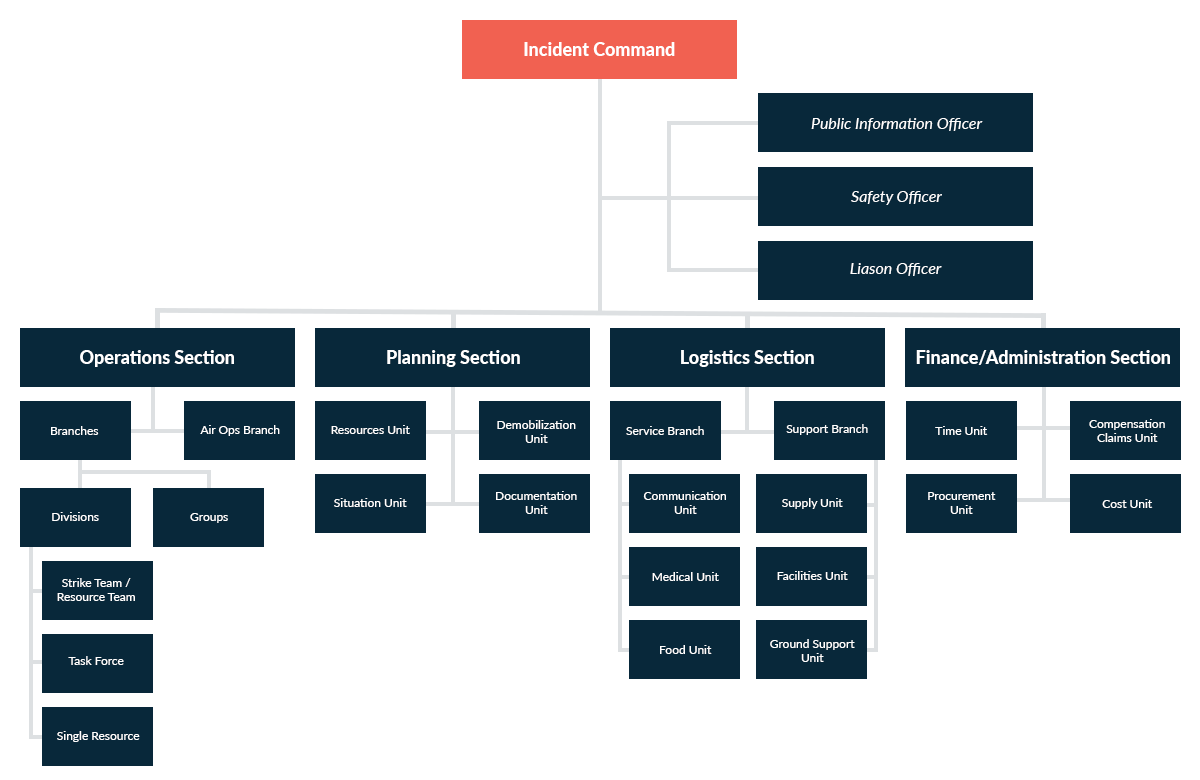Building Your Incident Management System: Understanding the Incident Command System (ICS)
The Incident Command System (ICS) is a standardized emergency management approach widely used across both public and private sectors. Initially developed by FEMA in response to natural disasters and large-scale emergencies, ICS provides a framework for coordinating resources, personnel and communications to manage incidents effectively. ICS is only used for incident management and does not guide incident preparation or recovery.
For businesses, adopting the ICS structure can help ensure a coordinated response during an emergency, reducing chaos and confusion. Here’s a breakdown of the key components that will help your organization integrate ICS into its incident management system (IMS).
Key Benefits of ICS for Businesses
- Unified, Efficient Response: ICS offers a universal framework with standardized language and procedures, facilitating effective collaboration with public safety agencies, first responders, and other stakeholders during emergencies.
- Coordinated Response: ICS helps align your internal teams with public emergency services, allowing for smoother collaboration.
- Scalability and Flexibility: The system can handle anything from minor operational disruptions to full-scale emergencies and planned events such as large-scale conferences or product launches.
Overview of ICS’s Personnel, Task and Resource Structure
ICS organizes people, tasks and resources into functional areas, ensuring that all aspects of an emergency are covered. Here’s a breakdown of the core elements your business should understand and incorporate into its Incident Management System (IMS).
Command Structure
Basic Command Structure

Incident Command:
- Single Incident Commander: The individual overseeing all incident activities, including developing strategies and tactics and ordering and releasing resources. The Incident Commander manages and directs all operations at the incident site. A single Incident Commander typically oversees an incident involving a single jurisdiction; however, depending on the complexity of the incident, they may also manage a multi-jurisdiction effort. This is the only position that always needs to be staffed. For minor incidents, this individual could absorb all responsibilities.
- Unified Command: For incidents involving multiple jurisdictions, a Unified Command is established. This allows each participating entity to retain its authority, responsibility and accountability for its personnel and resources while leaders from each organization collaborate to jointly oversee and direct incident activities, establishing a shared set of objectives, strategies and a single Incident Action Plan (IAP).
Command Staff:
The Command Staff performs essential support functions for the Incident Commander, including coordinating with other agencies, ensuring incident safety and managing public information. Command Staff roles address vital responsibilities that the General Staff doesn’t cover. Additional positions as needed and assigned by the Incident Commander.
- Public Information Officer (PIO): Communicates incident-related information to the public, media and other agencies.
- Safety Officer: Oversees incident operations and advises the Incident Commander on all safety-related matters, including the health and well-being of incident management personnel.
- Liaison Officer: Serves as the Incident Commander’s point of contact for representatives of governmental agencies, non-governmental organizations (NGOs) and private-sector organizations. Functional Areas (each led by a section chief): Functional Areas / General Staff: This team, typically comprised of the Operations, Planning, Logistics and Finance/Administration, is responsible for the primary functional areas within the Incident Command structure. Depending on the incident, the General Staff may also include an Intelligence/Investigations function, which can operate within an existing staff section or as a standalone section.
- Operations Section: Prioritizes and directs tactical actions to meet incident goals.
- Planning Section: Collects, analyzes and disseminates incident information and facilitates action planning.
- Logistics Section: Secures and provides facilities, services and support, including communications, food and medical services.
- Finance/Administration Section: Tracks incident costs and coordinates financial and administrative resources. Additional Functional Area for Very Complex Critical Incidents:
- Intelligence/Investigations: Collects and analyzes data in cases involving potential criminal activities or complex situations.
Organizational Levels for Complex Situations

In more complex emergencies, ICS introduces additional organizational levels. To create a manageable span of control for each position, ICS organizes resources into Teams, Divisions, Groups, Branches and Sections. Ideally, there should never be more than one supervisor to five subordinates, but there may be cases where it is necessary to break this rule. If the supervisor-to-subordinate ratio becomes unmanageable, additional units can be created. Units can also be reorganized or demobilized if supervision is too limited for optimal control.
- Branch: An organizational level responsible for significant parts of incident operations by function, geography or jurisdiction. In the Operations Section, the Branch level sits between Section and Division/Group; in the Logistics Section, it’s between Section and Units. Roman numerals, functions or jurisdictional names may identify branches.
- Division: The level responsible for operations within a specific geographic area, positioned between the Strike Team and the Branch organizationally.
- Group: Established to separate the incident into functional areas of operation. Groups are positioned between Branches (if activated) and Resources within the Operations Section.
- Unit: An organizational element responsible for a specific function within incident planning, logistics or finance.
- Task Force: A group of resources with common communications and a leader may be pre-established and deployed to an incident or formed on-site.
- Strike Team/Resource Team: A designated combination of similar resources with shared communications and a leader. Single Resource: This is an individual piece of equipment with assigned personnel or a team with a designated supervisor, deployable to an incident.
Facilities to Help Manage Incident Response Personnel and Resources
Depending on the scale of the incident or event, response teams may require physical or virtual locations with specific functions to manage the situation effectively. Having these spaces facilitates discussions about progress and the gathering, preparation, or delivery of resources. Below are some common facilities needed when utilizing ICS.
- Incident Command Post (ICP): Every incident or event will have an ICP. This location is where the Incident Commander oversees the incident.
- Staging Areas: Temporary location(s) where personnel and equipment wait for assignments. They are positioned close enough for quick response while remaining outside the impact zone. A manager reporting to the Operations Section Chief or Incident Commander will oversee each location.
- Base: The primary location for essential services and support, such as feeding and resupply. There is only one Base per incident, which is not required for all incidents.
- Camps: These are auxiliary sites for resources when the Base is not accessible. Helibase/Helispots: Designated areas for helicopter operations. Helibases serve as long-term locations for refueling and maintenance, while Helispots are temporary sites for loading and unloading. Large incidents may need multiple Helibases and Helispots.
Resource Management
The Incident Command System (ICS) breaks resource management into three management principles - planning, which involves assessing the situation, setting objectives, choosing a strategy and allocating resources efficiently, all in a cyclical, continuous process throughout an incident; organizing, which strategically groups resources to meet objectives, ensuring clear command and effective communication structures and supervising which directs and controls resources to achieve objectives, including evaluating performance and making adjustments as necessary.
Each ICS function uniquely supports the three-step resource management process.
- Command: Sets objectives, authorizes orders and manages demobilization.
- Operations: Assigns resources to fulfill objectives.
- Planning: Tracks resources and anticipates shortages.
- Logistics: Orders and supports resources.
- Finance/Administration: Manages resource costs.
Efficient planning and clear strategies help avoid compounding mistakes. Demobilization should be planned early to ensure safety, cost-effectiveness and readiness for future incidents.
Why Businesses Should Embrace ICS
Integrating the Incident Command System into your business doesn’t have to be complicated. By understanding ICS’s roles, structure and purpose, your company can create an adaptable, scalable incident management system that aligns with public safety agencies and ensures a swift, coordinated response in times of crisis.
With this in place, your business can face any emergency confidently, minimizing downtime, protecting assets and keeping everyone safe.
Learn more about incident management at 911cellular.com.
Tags: Incident management







